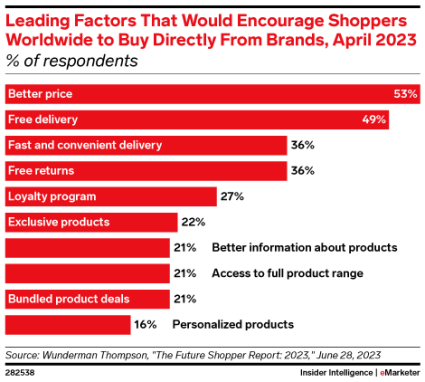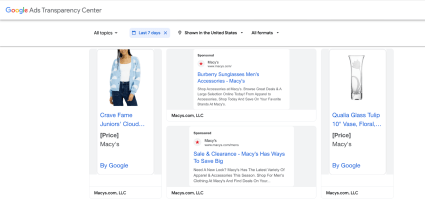Consumers in 2024 are looking for deals. Challenging economic circumstances and a seemingly endless array of options available online have made shoppers more opportunistic and less swayed by brand loyalty when choosing between products.
According to eMarketer, 59% of customers will switch products if they find a cheaper option, and almost one in five feel they can’t afford to be loyal anymore. Brands need to work harder than ever to attract new customers and hang on to the ones they already have.
That’s where promotions come into play. It’s no secret that a big sale attracts both new customers and old ones who may have drifted away. But you’ll need to go above and beyond business as usual to win in a competitive promotional environment. How can you deploy promotions effectively to cut through the noise, get potential customers’ attention, and earn their dollars?
Revamp your promo calendar for 2024
First, you need to understand the value of your brand’s promo calendar. Setting the right schedule from the get-go can make or break your promotional strategy all year long. Instead of simply copying last year’s calendar onto the new year, you should start by analyzing your pre- vs. post-promo campaign results from previous years to see what worked and what didn’t.

Source: eMarketer
Updating your promotional calendar is critical to your success: too many brands make the mistake of repeating the same promotions year after year. It will always be easier to just recycle old promos–especially if they helped your brand hit goals in previous years–but that practice will create more problems in the long term.
Over time, you’ll train your customers not to shop but to wait for promotions at a particular time of year, every year. Look for opportunities to break the pattern and surprise your customers with exciting new deals by refreshing your promotional calendar on a regular basis.
It’s true that some seasonal elements of the calendar aren’t necessarily up for debate, especially when it comes to the holidays and Q4. But that doesn’t mean you should keep doing what you’ve always done: don’t repeat the same deals on the same holidays every year. Instead, look for ways to refresh your offerings by brainstorming ways to reframe the same holidays with new or unique creative, different deals, or exciting customer perks.
You can also switch it up by changing the timing of your offers. Take a look at the success of each promotional campaign over time and update the timeframe based on those learnings. For example, if a promo from last year lasted five days, but conversion volume started to soften after three days, cut the time of that promo down to the days when it was most effective.
Remember, your goals isn’t to train customers to wait for a promotion to purchase. Instead, your marketing should focus on generating interest in your brand’s products, then bringing in surprise sales to help drive revenue and delight customers.
Leverage the power of short-term promotions with flash sales
If your regular promotions aren’t performing as well as you’d hoped, flash sales are a great way to add extra oomph to your strategy. A short-term sale on a specific product can be more successful than a longer sitewide discount because it’s automatically more targeted, more interesting, and more urgent, pulling in a subset of customers who are willing to move fast for a good deal. These short sales also give brands an opportunity to advertise a specific popular product, rather than relying on more general advertising of an overall sale.
Running a flash sale is an efficient way to:
- Get customers to impulse-buy online: With the right product, your sale can pull in scrolling customers and convince them to purchase immediately by offering a great limited-term deal that incentivizes them to buy right now
- Increase short-term sales: If you’re looking for a quick, immediate boost in sales, a flash sale is a great way to achieve that
- Sell through excess inventory: Since they can target particular products, flash sales can help you sell out specific items when you have too much inventory
To make the most of flash sales, start with search: look at keyword and product trends to identify what is currently generating an uptick in traffic and conversion volume. With the Insights tab in Google Ads, you can even see what keyword categories are trending and when a certain category is expected to peak in search demand.
Your team should also be regularly auditing product category performance month-over-month and year-over-year to keep track of what’s selling well. Social listening can also provide a lot of insight into specific categories or products consumers are talking about. You can then run a flash sale focused on those specific products or a category to drive the best possible conversion rate.

Source: MagicBrief
Short-term sales are also a great way to test channel-specific promotions. You can create different activations for different channels so you can see what works best for your audience and if customers prefer different products or discounts on certain channels.
To get started, try creating different promo codes dedicated to different channels, like one for paid search and one for paid social. Then market those promo codes via the different channels and keep track of which are the most successful. In the future, you can use these insights to decide how much to invest in promotions for each category.
Stay ahead of the competition with comparison insights
Brands should also be keeping a close eye on the competition. Monitor your competitor’s ads on search, social, YouTube, and elsewhere when your brand is having a sale to get more impactful, accurate, and actionable information on what the competition is doing at the same time.
Use tools like Google’s Ads Transparency Center to check out other brands’ advertising. While you should be extra focused on comparisons when you know other brands are running sales, like Black Friday and Cyber Monday, you should also be reviewing similar brands’ ads regularly throughout the year to get new ideas for sales and creative your brand could try.

Source: Google Ads Transparency Center
Another good way to get insights into competitors’ strategies is to subscribe to their email lists, which will give you an accurate idea of when their sales are and how they’re promoting them via email.
By staying up to date on your competitors’ promotional strategies, you can get a good idea of the ads that are popular right now with the audiences your brand wants to attract. But you shouldn’t just copy what other brands are doing: look out for trends that are overused and especially for potential gaps in the market that you can leverage to stand apart from other brands in your category.
You can use these insights to make real-time adjustments to your strategy. If you identify a gap or you’re seeing your competition using deeper discounts, consider switching up elements of your promotion to take advantage of what’s working or capitalize on an opportunity.
No matter what, remember to keep trying new sales and creative to get the most out of your promotional strategy. To be successful in 2024, your brand’s promotions need to stay competitive, not repetitive.








Responses